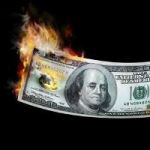 The U.S. national debt recently topped $37 trillion. This comes to over $323,000 for every U.S. taxpayer.
The U.S. national debt recently topped $37 trillion. This comes to over $323,000 for every U.S. taxpayer.
What’s more, $37 trillion amounts to a debt to gross domestic product (GDP) ratio of over 123 percent. For perspective, the debt to GDP ratio was just 57 percent in the year 2000. Less than half of today.
Back then, the federal budget deficit was practically a non-issue. Washington, for a brief moment, even ran a budget surplus. The Congressional Budget Office (CBO) was so excited by this that it forecast continuous surpluses for years to come.
But, alas, it was not to be. Today, a quarter century into the new millennium, we’re facing record debt and runaway deficits. In fact, the monthly Treasury statement for the 2025 fiscal year through May 31, shows a deficit of $1.365 trillion. Yet there’s still four months left in the 2025 fiscal year to go.
This means the U.S. government will likely run a $2 trillion deficit for this fiscal year, which would be somewhere between 6 and 7 percent of GDP. And that’s assuming there isn’t a major war or recession to really blow out the budget.
Something has obviously gone incredibly wrong over the last 25 years. Much of it, unfortunately, has been self-inflicted. Significant tax cuts, high-priced wars of choice, the 2008 financial crisis, skyrocketing healthcare expenditures, the coronavirus fiasco, and other costly acts of madness.
The politicians in Congress have failed to do their jobs. Republicans and Democrats have both found it politically impossible to get a handle on spending.
Democrats, when they held both Congress and the White House under President Joe Biden, let spending continue to slip and slide away. Now, Republicans, with President Trump in the Oval Office, are proposing greater spending while continuing with tax cuts.
This ensures the debt problem will get worse and worse. Here’s a look at how we got into this mess…
Exploding Deficits
Bill Clinton, for all his faults, had the luck of perfect timing. He came into office at the end of the Cold War and benefited from a technology-driven economic boom. At the close of his presidency in 2000, the CBO forecasted budget surpluses extending well into the future – with a projected budget surplus of 4.3 percent of GDP by 2010.
Things took a distinct turn after 9/11. George Dubya Bush pursued tax cuts while also paying for wars in Afghanistan and Iraq. Annual deficits quickly returned.
Deficits really exploded following the 2008-09 financial crisis and recession. The Obama administration executed a mega bailout with the American Recovery and Reinvestment Act in 2009. Several years later almost all of Bush’s tax cuts were extended. By then, the CBO’s deficit forecasts were pointing steeply upward.
Trump 1.0 enacted additional tax cuts in 2017. He also continued to increase spending. Then the coronavirus fiasco blew budgets out of the water. The government passed reckless stimulus measures in 2020 and 2021 to soften the impacts of its own lockdown mandates on households and businesses.
The budget deficit dropped to 3.9 percent of GDP in 2022. But then spending was ramped up once again. Higher interest costs, increasing Medicaid entitlements, and clean energy laws enacted by Joe Biden pushed the deficit to 7.4 percent of GDP in 2023. The CBO is now forecasting deficits around 6 percent of GDP through 2035.
The version of President Trump’s One Big Beautiful Bill Act (OBBBA) passed by the House is projected by the CBO to increase the primary deficit by $2.4 trillion over the 2025 to 2034 period. This would push the deficit to 6.8 percent of GDP by 2034.
Moreover, as the debt and deficits continue to increase the value of the dollar will continue to decrease…
Dollar Weakness
Year to date the dollar, as measured by the dollar index, is down over 10 percent. A loss of over 10 percent in the value of the dollar compared to foreign currencies over a six-month period is a huge move. However, Trump may welcome this. For it aligns with his trade and reshoring policies.
If you asked an economist, he or she would tell you that a weaker dollar provides a boost to U.S. exports. As U.S. goods and services become relatively cheaper for foreign buyers, they will consume more of them. In other words, a weaker dollar makes Made in the USA products more competitive in international markets, and potentially increased demand for U.S. exports.
Greater U.S. exports would stimulate domestic manufacturing and agricultural production, and related jobs. At the same time, with U.S. exports becoming more competitive and imports becoming more expensive, a weaker dollar can help to reduce the U.S. trade deficit.
On the flip side, a weaker dollar makes imported goods and raw materials more expensive for U.S. consumers and businesses. This can lead to higher prices for a wide range of products, which would add to rising consumer price inflation.
Companies that rely heavily on imported components or materials may see their input costs rise. These cost increases would mainly be passed on to consumers. So, while there would be more manufacturing jobs in the U.S., the costs of goods and services would rise.
A sustained decline in the dollar’s value is also a red flag for foreign investors. Specifically, a weaker dollar could deter foreign investment in U.S. assets. It could also lead to capital outflows. In addition, as the U.S. trade deficit shrinks, trade partners will have fewer dollars to recycle back into U.S. Treasuries.
Here, again, it all comes back to U.S. government debt and deficits…
Be Careful What You Wish For
If foreign investors reduce their holdings of U.S. Treasuries, then who will pick up the slack? If foreign central banks are not buying Treasuries, how will the government finance its debt?
Will Uncle Sam require 401(k) accounts and IRAs invest a specified amount in Treasuries at a time when government debt’s turning to rot faster than ripened tomatoes? Will the Federal Reserve resume its program of creating credit from thin air to buy Treasuries?
We shall certainly find out.
In the meantime, there’s a great big interest rate standoff between Trump and Fed Chair Jerome Powell. Trump wants the Fed to cut interest rates now so it will be cheaper for the Treasury to finance its massive pile of debt. Fed Chair Powell says too bad.
On Tuesday, in advance of Powell’s testimony to the House Financial Services Committee, and after calling him a “Total and Complete Moron!”, Trump hammered out this this lengthy TruthSocial post:
‘“Too Late” Jerome Powell, of the Fed, will be in Congress today in order to explain, among other things, why he is refusing to lower the Rate. Europe has had 10 cuts, we have had ZERO. No inflation, great economy – We should be at least two to three points lower. Would save the USA 800 Billion Dollars Per Year, plus. What a difference this would make. If things later change to the negative, increase the Rate. I hope Congress really works this very dumb, hardheaded person, over. We will be paying for his incompetence for many years to come. THE BOARD SHOULD ACTIVATE. MAKE AMERICA GREAT AGAIN!”
Powell, during his testimony, stated he’s holding off on rate cuts until he can better understand the impact of tariff-driven price increases.
Here at the Economic Prism, we don’t know what interest rates should be. But neither does Powell or Trump. This is a price that’s best left up to the credit market to decide.
We do know that after bottoming in July 2022, interest rates have entered a secular uptrend that could extend to 2060 – or longer. Fed intervention to cut interest rates now would be like trying to cool a swimming pool with ice cubes.
At this point, if like Trump you’re eager for rate cuts, be careful what you wish for…
Powell’s stand may be all that’s keeping the dollar from going into complete freefall – and capital outflows from really taking flight.
Should this happen, digital printing press money would be all that’s left to finance the debt.
[Editor’s note: Have you ever heard of Henry Ford’s dream city of the South? Chances are you haven’t. That’s why I’ve recently published an important special report called, “Utility Payment Wealth – Profit from Henry Ford’s Dream City Business Model.” If discovering how this little-known aspect of American history can make you rich is of interest to you, then I encourage you to pick up a copy. It will cost you less than a penny.]
Sincerely,
MN Gordon
for Economic Prism





With the dollar down about 10% in a vry short time, does that qualify for free fall?
Here in Germany I wont buy American products regardless of a cheaper price, supporting non hostile economies is more important.
Thank you Hubertus
You aren’t paying attention
Germany is the country that has been de-industralized and racially destroyed
You used to be the powerhouse of the EU, but not now
The German DVD is the most destructive of the intel agencies
Your government is run by Communist Satanists
For a people that tolerate sex markets you are reaping what you have sowed
The USA doesn’t need perverts to buy their products
You asked to be replaced. You are getting it.
Before lecturing me, we did not vote for a rapist as a president in Germany, anyway I am not a pervert and I just boykott your products.
DVD is more active in USA than elsewhere, just watch who is in charge of your government.
Enjoy the ride.
By the way, the left (formerly communist) party together with the green party in Germany are the ones fighting for human rights and the constitution. Funny how things develop.